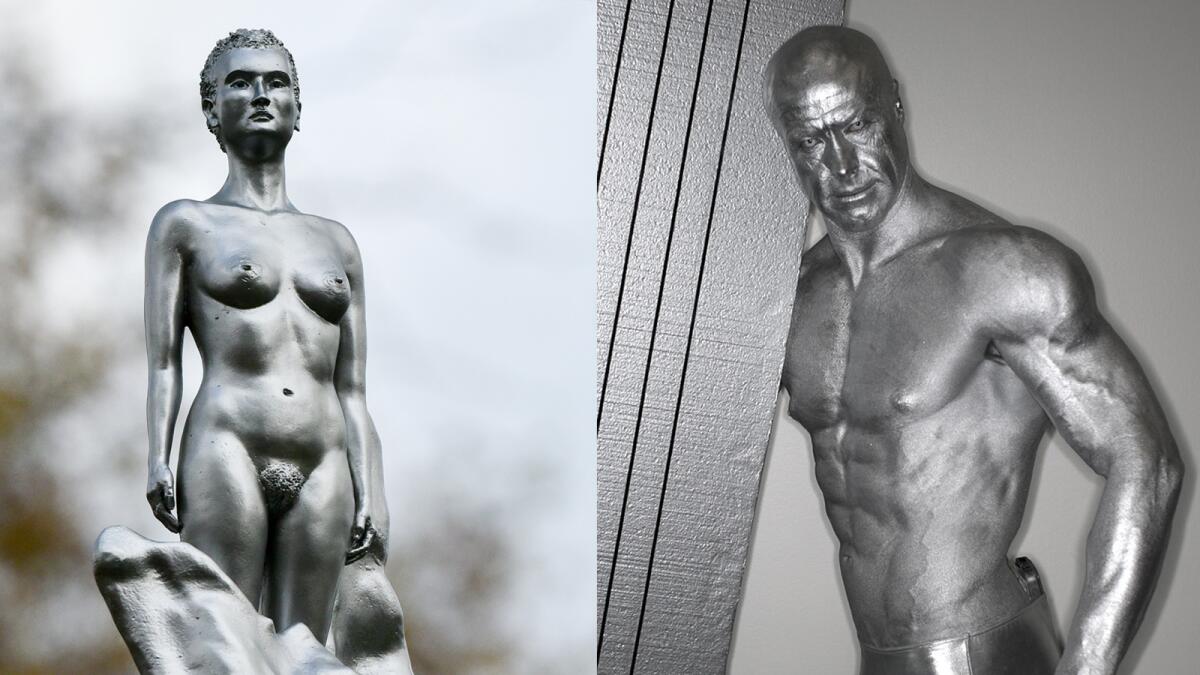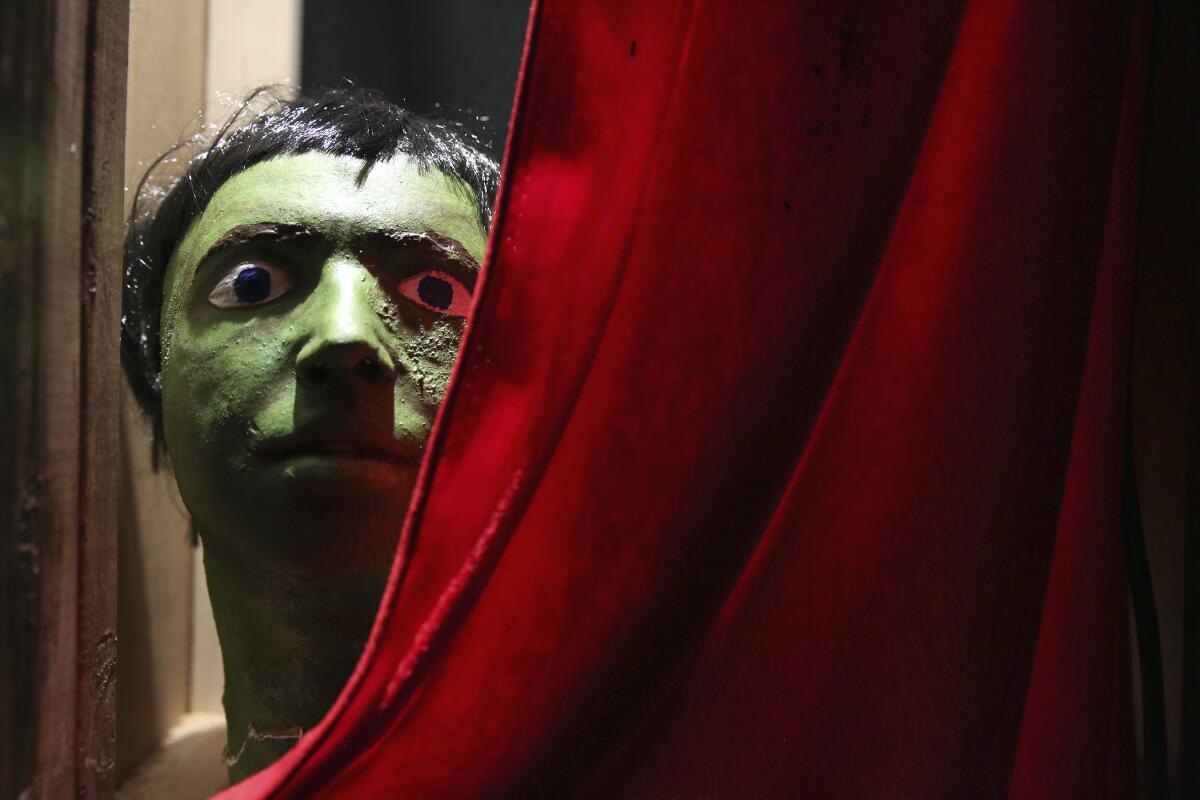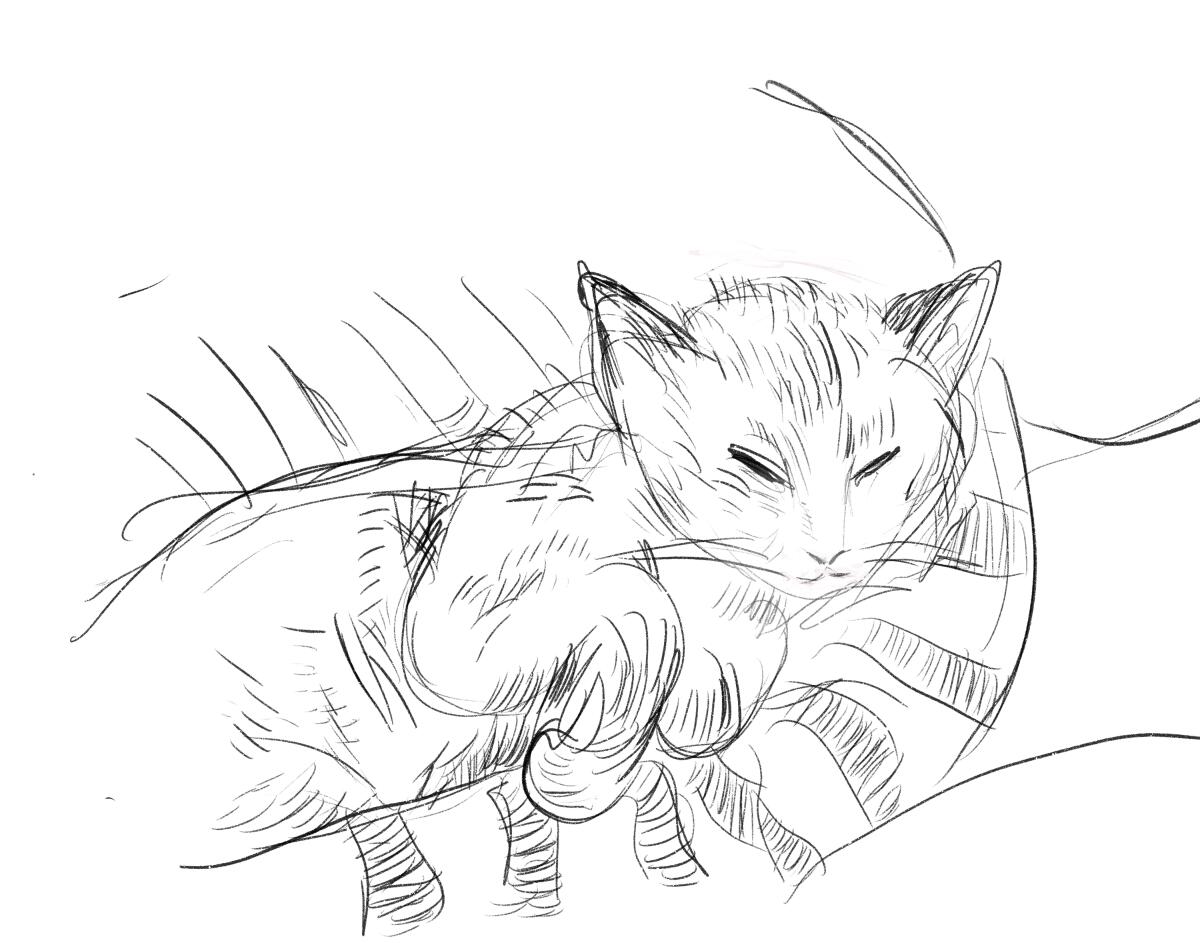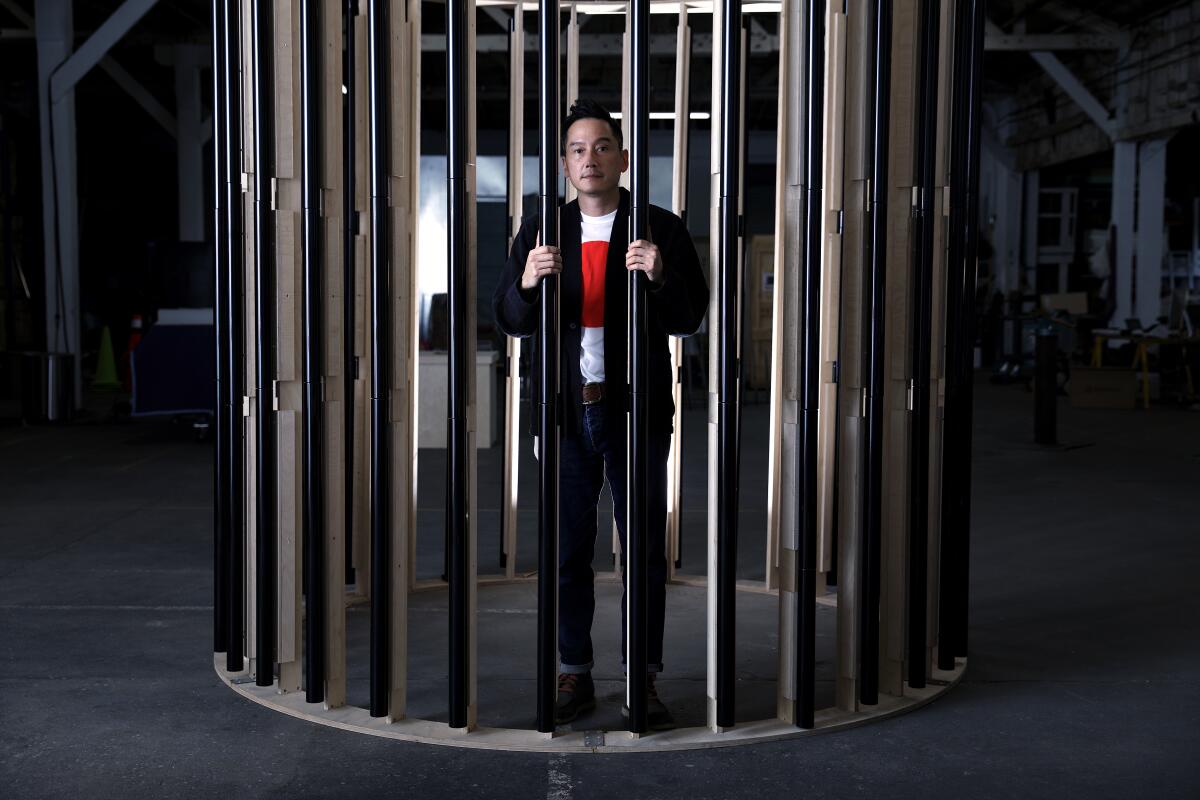Essential Arts: A beloved feminist gets a statue. The statue gets jeers
- Share via
It’s the weekend and I’ll be distracting myself with warm carbs and repeat viewings of the French spy thriller “The Bureau.” I’m columnist Carolina A. Miranda, of the Los Angeles Times, and I also have some essential art news.
My eyes are up here
Another wonderfully botched restoration in Spain — a.k.a. the “potato head” of Palencia — got lost in the social media shuffle this week after a tony neighborhood in London unveiled a statue in honor of 18th century feminist author and thinker Mary Wollstonecraft. The highly puzzling statue, by British sculptor Maggi Hambling, features a small, nude figure of a woman — not Wollstonecraft — being ejected from a foamy blob of silvery bronze.

Following its unveiling, the monument was immediately flamed on the internet.
“Thanks I hate it???” tweeted novelist Imogen Hermes Gowar, an art historian who has worked at the British Museum as a gallery assistant. Diane Abbott, the MP for Stoke Newington, the neighborhood in which the statue appears, described it as “Tiny, shiny and completely inappropriate.” And, in a scathing write-up, art critic Jerry Saltz of New York magazine, compared it to “a Rolls-Royce hood ornament by way of a sketchy Disney ‘Fantasia’ figure.”
Even the popular Whores of Yore Twitter feed (@WhoresofYore; 438,000 followers), an account founded by scholar Kate Lister to explore the history of human sexuality, weighed in on the design: “I, for one, am loving the new Mary Wollstonecraft statue. I had no idea Mary had shredded abs or bouffant pubes.” (Hilar — though, to reiterate, the statue is not a depiction of Wollstonecraft.)
Make the most of L.A.
Get our guide to events and happenings in the SoCal arts scene. In your inbox every Monday and Friday morning.
You may occasionally receive promotional content from the Los Angeles Times.
One of the simmering issues that the monument has raised is how women are depicted in public art.
Female historical figures make up a stark minority of civic monument depictions in many cities. Only five of the 178 works in the city of L.A.’s outdoor collection feature a real-deal woman from history. When women are featured in monuments, it is often as muse or symbol — and often without clothes. “Nameless, nude and conventionally attractive,” as Gowar wrote in her thread.
And that’s not just outdoors. In the 1980s, the Guerrilla Girls art collective famously tallied up representation at New York’s Metropolitan Museum of Art and noted that while only 5% of the artists in the museum’s modern art collection were women, 85% of the museum’s nudes were female.
Hambling, however, defended her choice in the Evening Standard, noting that the statue is making a larger point about women at large — not just Wollstonecraft: “The point is that she has to be naked because clothes define people. We all know that clothes are limiting and she is everywoman.”
As someone who has written more than my share of stories about explicit art for the Los Angeles Times, I’m totally cool with nudity. But using it to pay tribute to a female author who actively advocated for women to be judged for their minds, not their physical qualities — and was labelled “a hyena in petticoats” — strikes me as a spectacular oversight. As Wollstonecraft wrote in “A Vindication of the Rights of Women”: “The first object of laudable ambition is to obtain a character as a human being.”
Does this monument achieve that? A gander at the photos (and tweets about “bouffant pubes”) would lead me to say no.
Which brings me to the work’s aesthetics. I haven’t seen the sculpture in person. But there’s a pandemic going on and I just cracked two fillings gritting my teeth through the presidential election, so I’m going to bend all the rules about critiquing work you haven’t seen IRL. And all I gotta say is...
Memo to Marvel: The next Silver Surfer should definitely be played by a woman.

A biennial in limbo
The Hammer Museum’s “Made in L.A.” biennial, which this year is also being shown at the Huntington Library, is fully installed. You just can’t see it. L.A.’s high-profile contemporary art show hangs in the balance as museums await permission from the government to reopen — even as shopping malls and hair salons have been given the go-ahead.
“The implication is that malls, nail salons and the like are somehow safer for the public than museums,” writes The Times’ Deborah Vankin. “And the ramifications are profound, not just for museumgoers missing out on culture and connection but for institutions losing revenue and for staffers who are furloughed or laid off.”
Last month, The Times’ editorial board argued that museums should be allowed to re-open: “If these facilities can reopen as safely as shopping malls or tattoo parlors, state health officials should find a way to let them do so.”

The Times’ Christopher Knight, in the meantime, reviews the biennial, which was organized by Hammer assistant curator Ikechukwu Onyewuenyi, with independent curators Myriam Ben Salah and Lauren Mackler. “Most of the 30 artists are L.A. immigrants, hailing from elsewhere in the U.S. or abroad,” writes Knight of this year’s line-up. “Several choose to live and work in more than one place. The pointed selection judiciously rejects blood-and-soil nationalism, even on a civic level, that stains today’s larger social and political culture. It doesn’t matter where you’re from, it only matters what you do.”
Election 2020 & the arts
In the wake of Kamala Harris’s ground-breaking ascension as vice president-elect, a viral image circulated online that showed Harris walking alongside the shadow of Ruby Bridges, the first Black student to desegregate the all-white William Frantz Elementary School in Louisiana. Times columnist Erika D. Smith tracks down Gordon Jones and Bria Geoller, the creators of the image, which was inspired by the 1963 Norman Rockwell painting “The Problem We All Live With.” The story, interestingly enough, starts at a pub in Sausalito...
Last weekend, when the networks declared Joe Biden the projected winner of the presidential election, streets across the United States filled with people dancing. Makeda Easter rounds up who was shaking what, whether it was “on beat, off beat, line dances and voguing” — in a story that features plenty of joyous video.
And Anna Orso of the Philadelphia Inquirer writes about how groups in that city intentionally countered potential unrest with dance.
Times theater critic Charles McNulty reports on how he is trying to detox after months of election doomscrolling. “I didn’t become a drama critic to track the maneuvers of petty bureaucrats,” he writes. “I became a drama critic to try to capture in prose the fleeting sublimity of the stage. I want my mind back.”
TV critic Robert Lloyd, meanwhile, writes of the pleasures of joyscrolling ... and how turning off TV news this week left him plenty of time to draw his cat.

In the arts
Artist Glenn Kaino has just completed two major new installations — collaborations with scientists from NASA’s Jet Propulsion Laboratory for the new Long Beach art space Compound — and Deborah Vankin paid him a studio visit to have a look. The works, Kaino tells her, make abstract scientific concepts palpable: “They’re intended to create moments of visibility for things that are invisible around us.”

Plus, Makeda Easter has the story of two artists who connected romantically and artistically after the death of a mutual friend. In the wake of that loss, Cristina Martinez and Al-baseer Holly found a way to collaborate on work even though Martinez lives in Seattle and Holly is based in L.A. Their work has drawn the attention of Hollywood and the music industry, and it’s been displayed at the Museum of Contemporary Art Cleveland. This weekend they are once again teaming up: for a show at East Angel in Boyle Heights.
Enjoying this newsletter? Consider subscribing to the Los Angeles Times
Your support helps us deliver the news that matters most. Become a subscriber.
In the meantime, I examine the recent deaccessioning controversy at the Baltimore Museum of Art. The planned deaccessions were not in the spirit of rules established by the Assn. of Art Museum Directors to contend with the financial fallout of the pandemic. But what should not be lost is the promise that came with the thwarted plan: Namely, to establish pay equity for low-paid workers, including museum guards earning $13.50 an hour. As I note in the story: “A museum charged with stewarding works by Rembrandt and Titian shouldn’t be operating on a Walmart wage model that leaves workers eligible for public assistance.”
Performance notes
The Times’ Jessica Gelt reports on the Pacific Opera Project’s new drive-in production: “Covid fan Tutte,” inspired by Mozart’s “Così fan Tutte,” about two women spending their quarantine at a SoCal golf resort. The show will take place in the parking lot of a church in Ventura County. “It was just so amazing to make music with people again,” says bass baritone Colin Ramsey. “Not hearing music over a computer or on Zoom. Just to be together experiencing that tangible energy you feel with people.”

Gelt, who has been very busy this week, also reports on how the Kirk Douglas Theatre in Culver City, part of the Center Theatre Group, has transformed itself into a digital studio for streaming theater. And the journey from stage to screen, she writes, “is gripping drama unto itself, a tale of overcoming adversity and finding meaning and connection in the darkest hours.” She follows playwright Luis Alfaro as he prepares to stream two works later this month: “Mojada” and “Electricidad.”
Essential happenings
Matt Cooper has got the online culture goods with 17 culture picks for the weekend, including streams of “Matthew Bourne’s Swan Lake” and a performance by Chicano Batman. These are all the grooves I need.

Also on Matt’s agenda: seven IRL culture happenings, including a drive-through Christmas event in Pomona inspired by the popular children’s book “The Elf on a Shelf.”
The museums may be closed, but the galleries are open! And John Valadez’s “Pinturas Pandemia!” provides some good viewing at Eastern Projects in Chinatown. It turns out that while the rest of us have been doomscrolling, Valadez has been furiously painting — creating works that imbue the traditions of Western art with Mexican popular culture and the Indigenous figure in ways that are funny, pointed and surreal. The show is on view through Nov. 28. Do not miss!
And now for some drive-by art: LACMA curator Rita Gonzalez, Joe Mosconi of the Poetic Research Bureau and artist and curator Warren Neidich have teamed up with writer and editor Andrew Berardini to place artist haiku poetry on the marquee of the Theatre at the Ace Hotel. On view through Dec. 9.
Plus, plus: the Autry Museum of the American West is staging its American Indian Arts Marketplace this weekend and it’s all going down virtually. The lineup includes theater, artist conversations, films and, of course, the marketplace!
In other news
— Architecture critic Justin Davidson on why that crazy news conference in front of Four Seasons Total Landscaping in Philly serves as a fitting monument to the Trump administration.
— Kriston Capps at Bloomberg Citylab has a fascinating story about how Trump may not have signed an executive order to make federal architecture Neoclassical, but it appears that some of those mandates are nonetheless happening courtesy of the General Services Administration.
— Also in Citylab, Patrick Sisson writes about the possible second lives of empty office space.
— A great look at a suburban community in Wisconsin that fought a low-income housing development — only to discover afterward that the development didn’t ruin their suburb as predicted.
— I really enjoyed this profile of artist Michael Rakowitz.
— A pair of shows at LACMA and the Guggenheim will explore Modern and avant-garde Korean art.
— Painter and illustrator Edel Rodriguez has become known for his fiery anti-Trump political cartoons. He talks with Hyperallergic about why he has felt an urgency to deal with these topics.
— The story of Nannette Streicher, the woman who built Beethoven’s pianos. Fascinating.
And last but not least ...
Some proposed schematics for the Presidential Library of Donald J. Trump.
The biggest entertainment stories
Get our big stories about Hollywood, film, television, music, arts, culture and more right in your inbox as soon as they publish.
You may occasionally receive promotional content from the Los Angeles Times.




